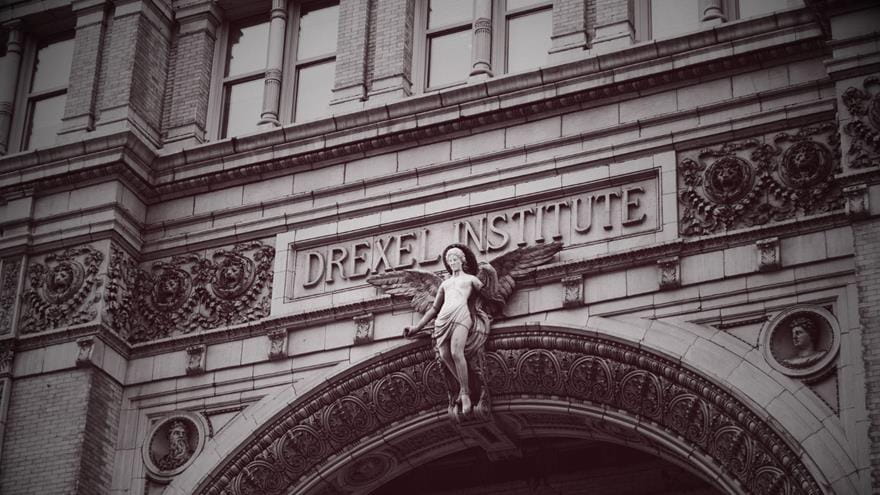A Detailed Look at the Effects of Drexel’s Enrollment and Retention Strategy at University Town Hall

Drexel’s new enrollment and retention strategy has affected the tuition-driven University but ultimately sets it up to succeed in the competitive and changing higher education landscape, according to President John Fry and key members of his cabinet at a town hall meeting on Jan. 11 in the Mandell Theater.
The event, called “State of the University 2017 and Beyond,” focused on the University’s decision two years ago to admit smaller class sizes to better retain and support students. Enacted after years of following a high “volume-based” approach that admitted insufficiently prepared students who were less successful at reaching graduation, the plan will help Drexel transition into a stronger private research university in a time in which higher tuition costs and lower enrollments are impacting colleges and universities across the country.
President Fry told the audience that Drexel’s financial position was strong, and that changes the University was undertaking would ensure that Drexel adapted well to secular changes in higher education. Drexel’s smaller enrollment size meant there would be a five-year transitional period ending in 2020 in which the University adjusts to accommodate decreases in tuition revenues.
Fry discussed the endeavors taken to support Drexel in that period alongside Senior Vice President of Enrollment Management and Student Success Randall C. Deike, PhD; Executive Vice President, Treasurer and Chief Operating Officer Helen Y. Bowman; Executive Vice President and Provost M. Brian Blake, PhD; Senior Vice Provost of Research Aleister Saunders, PhD; and Senior Vice President of Institutional Advancement David L. Unruh.
“Places like ours should be able to, if we continue to do all of the right things, move forward,” said Fry.
The steps Drexel is taking include increasing financial aid, academic offerings, research opportunities, fundraising and implementing conservative financial planning.
To better attract the best fit of students to maintain Drexel’s selective classes, the University has restructured its admission and financial aid standards. This includes minimal rises in tuition costs, more comprehensive recruitment efforts across the country and around the world and increased financial aid and faculty and student support. On campus, Drexel is responding to the national rise in the cost of college by limiting tuition to a 2 percent increase for undergraduates and about a 3 percent increase for graduate students, depending on their program, with zero increase in the cost for room, board and fees.
Drexel is undergoing these changes in part to respond to demographic concerns affecting all institutions in the higher education field. In America, future incoming freshman classes across the country are projected to be more diverse in terms of ethnicity, race and physical background; at Drexel, efforts are underway and will be included to honor more inclusivity and cultures on campus. A national birthrate-based decline in freshman-aged children in the Northeast will greatly affect Drexel, which draws large amounts of students from Pennsylvania and neighboring states. As a result, a more concentrated effort to engage and reach out to high school students and counselors in other parts of the country is already underway and will be expanded.
The University as a whole has reshaped financial undertakings to find non-tuition dependent ways to increase revenue while reducing expenditures and improving efficiency — all self-imposed restrictions, according to Fry, that have left Drexel financially sound and marked with “A” ratings and “Stable” outlooks from ratings agencies like Moody’s and Standard & Poor.
Fundraising activities, which have brought in nearly $300 million since Drexel’s last campaign, greatly expanded in the past three years and will supplement those efforts even more with the announcement of a major $750 million campaign that will run until 2020. Past philanthropic efforts in recent years have helped Drexel name and endow schools, thanks to Thomas R. Kline’s record-breaking $50 million donation to the Kline School of Law and Dana and David Dornsife’s $45 million commitment to the Dornsife School of Public Health. Additionally, construction of the Raymond G. Perelman Center for Jewish Life was completely financed by private philanthropy, which was a first for the University.
Research, which represents the second-largest source of revenue after tuition, remains a priority in Drexel’s efforts to bolster its academic standing and quality of faculty and staff. More emphasis will be given to better support faculty research through grantsmanship and proposal development, expand esteemed and prestigious funding and awards from the private and public sectors to further Drexel’s reputation and research efforts with other academic institutions and bolster strategic initiatives on campus, such as the Drexel Areas of Research Excellence Program.
“If we approach this calmly, methodically, optimistically and transparently, we’re going to be fine,” said Fry.
The briefing for the “State of the University 2017 and Beyond” can be downloaded here.
In This Article
Drexel News is produced by
University Marketing and Communications.

